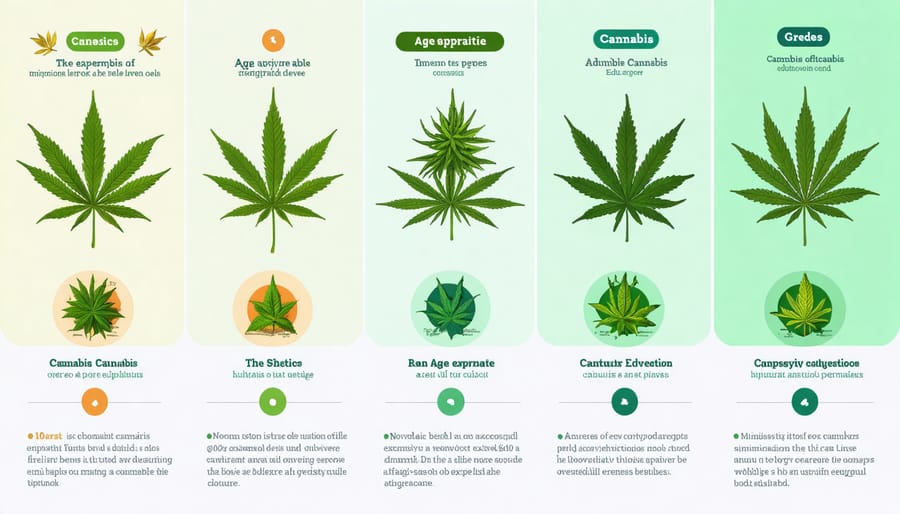As cannabis legalization continues to reshape North American society, K-12 schools face the critical challenge of developing evidence-based education policies that address Premium indoor THCA flowers and other cannabis products with scientific accuracy and age-appropriate messaging. The intersection of public health, education policy, and youth development demands a carefully structured approach that moves beyond traditional “just say no” messaging toward comprehensive drug education programs.
Current research indicates that nearly 60% of high school students lack access to scientifically accurate information about cannabis, creating an urgent need for standardized, research-based curriculum guidelines. While some districts have implemented innovative programs, many struggle to balance harm reduction approaches with zero-tolerance policies, highlighting the complexity of modern substance education.
This examination of cannabis education policy explores evidence-based frameworks, implementation strategies, and best practices for K-12 institutions, providing administrators and educators with practical tools to develop effective, age-appropriate programs that prioritize student well-being while maintaining educational excellence.
Current State of Cannabis Education in Canadian Schools
Provincial Variations in Cannabis Education
Cannabis education approaches vary significantly across Canadian provinces and territories, reflecting regional priorities and concerns. Ontario has implemented one of the most comprehensive programs, integrating cannabis education into its health and physical education curriculum from grades 6 through 12, with emphasis on harm reduction and informed decision-making.
British Columbia takes a public health approach, focusing on mental health connections and substance use prevention through its Physical and Health Education (PHE) curriculum. The province has developed specific learning resources that address cannabis use within the context of overall wellness and healthy choices.
Quebec maintains a more restrictive stance, emphasizing abstinence-based education and incorporating cannabis awareness into its broader substance abuse prevention programs. The province has invested in specialized training for teachers to deliver this content effectively.
Alberta and Manitoba have adopted flexible frameworks that allow school districts to customize their cannabis education programs while meeting provincial learning outcomes. These provinces provide educational resources that can be adapted to local community needs and cultural contexts.
The Atlantic provinces collaborate on shared resources and programs, though each maintains distinct implementation strategies. Northern territories have developed culturally responsive approaches that incorporate Indigenous perspectives and traditional knowledge into their cannabis education frameworks.
Despite these variations, all jurisdictions align with federal guidelines while tailoring content to address specific regional challenges and demographic needs.
Key Challenges in Implementation
Implementing cannabis education policies in K-12 settings presents several significant challenges that schools and districts must navigate carefully. One primary obstacle is the ongoing stigma surrounding cannabis, which can create resistance from parents and community members. This resistance often complicates the delivery of factual, evidence-based information to students.
Resource limitations pose another substantial challenge. Many schools lack adequate funding for comprehensive drug education programs, and there is a notable shortage of qualified instructors with specific expertise in cannabis education. Proper support for educators through professional development is essential but often insufficient.
The rapidly evolving nature of cannabis legislation and research creates additional complexity. Educational materials can quickly become outdated, requiring constant updates to maintain accuracy. Schools must also balance age-appropriate content delivery while ensuring comprehensive coverage of both health impacts and legal implications.
Cultural and linguistic diversity within student populations demands carefully tailored approaches to cannabis education. Materials and teaching methods must be culturally sensitive and accessible to all students, including those from communities with varying perspectives on cannabis use.
Furthermore, schools face the challenge of measuring program effectiveness while maintaining student privacy and confidentiality. Developing appropriate assessment tools that evaluate learning outcomes without stigmatizing students remains an ongoing concern for administrators and policy makers.
Evidence-Based Educational Strategies
Age-Appropriate Content Development
Developing age-appropriate cannabis education materials requires careful consideration of students’ cognitive development, emotional maturity, and existing knowledge base. Elementary school materials should focus on general health and wellness, decision-making skills, and understanding trusted adult guidance. These foundational concepts can be integrated into existing substance education programs without explicit discussion of cannabis.
Middle school content should introduce basic scientific information about cannabis, its effects on the developing brain, and social influences. This can be achieved through engaging classroom activities that promote critical thinking and peer discussion while maintaining educational appropriateness.
High school materials should comprehensively address cannabis topics, including legal implications, health impacts, and harm reduction strategies. Content should acknowledge that some students may have direct or indirect exposure to cannabis, emphasizing informed decision-making and responsible choices.
Key considerations for all grade levels include:
– Using age-appropriate vocabulary and examples
– Incorporating current scientific research and evidence-based information
– Avoiding scare tactics or exaggerated claims
– Ensuring cultural sensitivity and inclusivity
– Providing opportunities for student dialogue and questions
– Including parent/guardian communication components
Materials should be regularly reviewed and updated to reflect current legislation, research findings, and educational best practices. Educators should receive proper training to deliver content effectively and address student questions appropriately within their grade level’s scope.


Teacher Training Requirements
Effective cannabis education in K-12 schools requires comprehensive teacher training initiatives to ensure educators are well-equipped to address this sensitive topic. Professional development requirements typically include three core components: substance education fundamentals, age-appropriate teaching strategies, and cultural competency training.
Teachers must complete a minimum of 15-20 hours of specialized training covering cannabis pharmacology, health impacts, and current legislative frameworks. This foundational knowledge helps educators answer students’ questions accurately and address misconceptions effectively. The training should be updated annually to reflect evolving research and policy changes.
Instructional methodology training focuses on evidence-based approaches for different grade levels. Elementary school teachers learn to use prevention-focused messaging and social-emotional learning strategies, while secondary school educators receive training in harm reduction approaches and critical thinking development.
Cultural competency training ensures teachers can contextualize cannabis education within diverse community perspectives and values. This includes understanding various cultural attitudes toward cannabis use and developing inclusive communication strategies.
Resources for teacher training commonly include:
– Online learning modules
– Interactive workshops
– Peer mentoring programs
– Expert-led seminars
– Scenario-based learning exercises
School districts must maintain detailed records of completed training and provide regular opportunities for skill enhancement. Provincial education authorities typically require documentation of these professional development activities as part of their cannabis education policy compliance measures.
Policy Recommendations and Best Practices
Curriculum Integration Guidelines
Cannabis education can be effectively integrated into existing curriculum areas through careful planning and cross-disciplinary approaches. In science classes, educators can incorporate lessons about the endocannabinoid system, brain development, and the physiological effects of cannabis use within human biology units. Chemistry courses can explore the chemical compounds found in cannabis and their interactions with the body, while environmental science can address cultivation practices and ecological impacts.
Social studies and history classes present opportunities to examine the social, cultural, and policy implications of cannabis use, including its historical context and current legislation. Health and physical education courses naturally align with discussions about substance use, decision-making, and harm reduction strategies. Mathematics classes can utilize real-world data about cannabis use statistics and market economics to teach analytical skills.
Language arts courses can engage students through critical analysis of media representations of cannabis and develop media literacy skills. Business courses might address the economic aspects of the legal cannabis industry, including entrepreneurship and regulatory compliance.
To ensure appropriate implementation, educators should:
– Use age-appropriate content and language
– Align materials with provincial curriculum standards
– Employ evidence-based teaching strategies
– Focus on harm reduction and prevention
– Maintain cultural sensitivity
– Incorporate diverse perspectives and experiences
– Utilize interactive learning methods
– Include regular assessment of learning outcomes
These integration strategies should be supported by comprehensive teacher training and regular curriculum reviews to maintain relevance and effectiveness.
Stakeholder Engagement Strategies
Effective cannabis education in K-12 settings requires a coordinated effort among multiple stakeholders to ensure comprehensive and consistent messaging. Schools should establish clear communication channels with parents through regular newsletters, workshops, and information sessions that address cannabis-related topics and outline the school’s educational approach.
Healthcare providers play a crucial role by offering expert knowledge and evidence-based information. Schools can partner with local public health units, addiction specialists, and mental health professionals to develop age-appropriate content and deliver guest presentations. These medical experts can also provide valuable insights during policy development and curriculum review processes.
Community resources, including youth organizations, law enforcement agencies, and substance abuse prevention programs, should be integrated into the educational framework. These partnerships can provide additional support services, real-world perspectives, and specialized programming that complement classroom instruction.
To maximize engagement, schools should:
– Create parent advisory committees focused on substance use education
– Organize regular stakeholder meetings to review and update educational strategies
– Develop feedback mechanisms for all participating groups
– Establish clear protocols for addressing concerns and questions
– Maintain resource directories for families seeking additional support
Success in cannabis education relies heavily on maintaining open dialogue and collaborative relationships with all stakeholders while ensuring consistent messaging across different channels and platforms. Regular evaluation of engagement strategies helps identify areas for improvement and ensures the program remains responsive to community needs.

Evaluation and Assessment Methods
Effective evaluation of cannabis education programs in K-12 settings requires a multi-faceted approach combining both quantitative and qualitative assessment methods. Schools typically employ pre and post-program surveys to measure changes in student knowledge, attitudes, and behavioral intentions regarding cannabis use. These assessments evaluate understanding of health risks, legal implications, and decision-making skills.
Performance-based assessments, including role-playing scenarios and case studies, help gauge students’ ability to apply learned concepts in real-world situations. Educators often use rubrics to evaluate students’ critical thinking and problem-solving skills when addressing peer pressure and substance use decisions.
Long-term program effectiveness is measured through longitudinal studies tracking behavioral outcomes, substance use rates, and incident reports. Anonymous student feedback surveys provide valuable insights into program relevance and engagement levels, while teacher observations and classroom assessments offer immediate feedback on lesson effectiveness.
Data collection should include both cognitive and behavioral indicators:
– Knowledge retention rates
– Changes in risk perception
– Development of refusal skills
– Improvement in decision-making capabilities
– Reduction in substance-related incidents
Regular program evaluation enables continuous improvement and adaptation to emerging trends and student needs. Schools should establish clear metrics aligned with learning objectives and collect data systematically to ensure program accountability and demonstrate outcomes to stakeholders.
As Canada continues to navigate the complexities of cannabis legalization, the development of comprehensive K-12 education policies remains crucial for ensuring student well-being and fostering informed decision-making. The evidence gathered from existing programs demonstrates that effective cannabis education must be age-appropriate, scientifically accurate, and integrated within broader health and wellness curricula.
Key considerations for moving forward include the need for standardized educational frameworks that can be adapted to local contexts while maintaining consistency in core messaging. Schools must strike a balance between prevention-focused approaches and harm reduction strategies, ensuring that students receive factual information without stigmatization or fear-based messaging.
Professional development for educators emerges as a critical component for successful implementation. Teachers require ongoing training and support to effectively deliver cannabis education content and address students’ questions with confidence and accuracy. Additionally, school boards must establish clear protocols for handling cannabis-related incidents while maintaining a supportive educational environment.
Looking ahead, several priorities should guide policy development:
– Regular evaluation and updating of educational materials to reflect current research and emerging trends
– Enhanced collaboration between education authorities, health professionals, and community stakeholders
– Development of culturally responsive resources that acknowledge diverse perspectives and experiences
– Integration of digital learning tools and interactive content to engage modern learners
– Strengthened partnerships with families to reinforce educational messages at home
Success in cannabis education policy requires sustained commitment from all stakeholders and adequate resource allocation. As our understanding of cannabis use and its impacts continues to evolve, policies must remain flexible enough to incorporate new evidence while maintaining their fundamental focus on student health and safety.
Moving forward, Canadian schools have the opportunity to establish themselves as global leaders in cannabis education by developing evidence-based, comprehensive approaches that serve as models for other jurisdictions facing similar challenges.
